Making Cannelés

You often hear it said that cannelés are small, eggy “cakes”. Don’t you believe it. Cannelés are custards (with candy-like crusts) and need to be treated as such. I know what you’re thinking: Joe, what kind of custard gets baked at 525 degrees Fahrenheit? That answer is a HIGH HEAT custard, wise guy, and just like a low-heat custard, precautions must be taken to prevent a cannelé from absorbing too much heat too quickly, lest it form lots of bubbles, expand and ultimately break into a grainy, syrupy blob. I’ll explain on the way. Let’s get moving!
First, get your ingredients together. Combine the milk, butter, rum, vanilla and salt in a saucepan and brig it to the boil over medium heat.
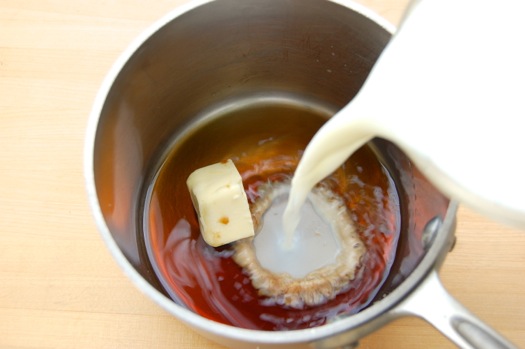
While the milk mixture is heating, whisk the egg and yolks in a large bowl.

Add the sugar…

…and whisk it together. Yes, you can use a whisk. People making cannelés worry a lot about air bubbles, and while you don’t want too many air bubbles in your batter, overly rapid heating is the thing you really want to guard against.

When the milk mixture reaches the boil, take it off the heat and pour about half into the egg mixture.

Stir it in with the whisk (don’t whisk it too much), then add the rest of the hot milk. Stir it to incorporate.
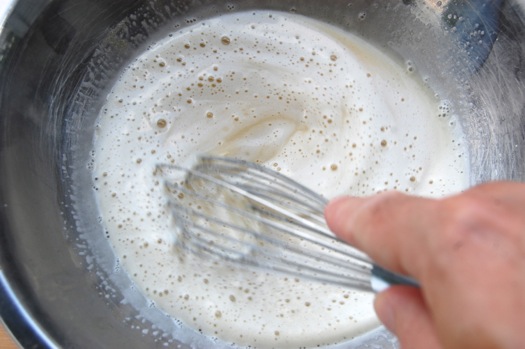
Now promptly sift the flour over the hot mixture…
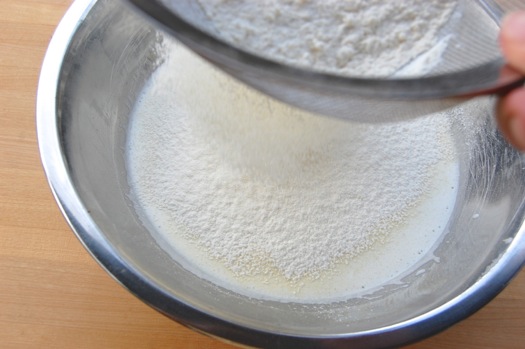
…and stir that in. Resist the urge to whip vigorously, we’ll take care of the lumps later. Anyway, so what are we doing here? A couple of things. We’re gently coagulating some egg proteins, but more importantly we’re gelatinizing starch. Which is to say, using wet heat to make the flour granules swell and fall apart. What’s the good of that? Well along with all the sucrose molecules, the starch is going to help keep the egg proteins from curling up too tightly in the heat (which would cause our custard to break). But more importantly the gelated granules are going to insulate those proteins when the batter hits the oven, so they don’t heat up too fast.

I know what you’re thinking: what can a little starch do to insulate a material as sensitive to temperature as egg? Oh, you’d be surprised.
Anyway, now pass the mixture through a fine mesh sieve to press out the flour lumps. You could probably do the mixing in a stand mixer with the whip if you wanted, as long as it was on low speed. I didn’t test that but it seems to work for other bakers, and it would eliminate the need for this step. Oh, if you’re really feeling confident in your cannelés you can stir in the seeds of a vanilla bean here (cut the extract down by half in that case). As with all custards, real vanilla makes these sing.

Just press the last few lumps through.

Stir it, pour the batter into a pitcher of some sort and refrigerate it at least 24 hours and up to three days if that’s more convenient.
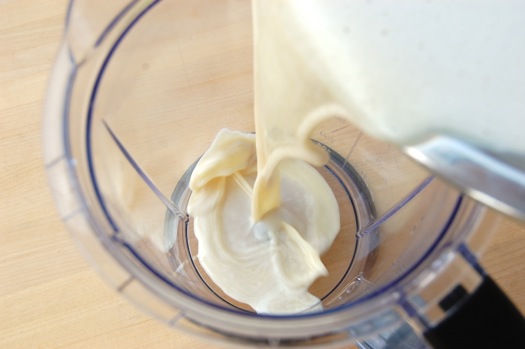
While you’re waiting you can make your “white oil” which is a beeswax lubricant that’s traditionally used with cannelés. It’s not strictly necessary, though it does give the cannelés a nice shine and a distinctive flavor. Just combine an ounce of beeswax (available from most honey sellers at farmer’s markets) with an ounce of butter and two tablespoons of vegetable oil.
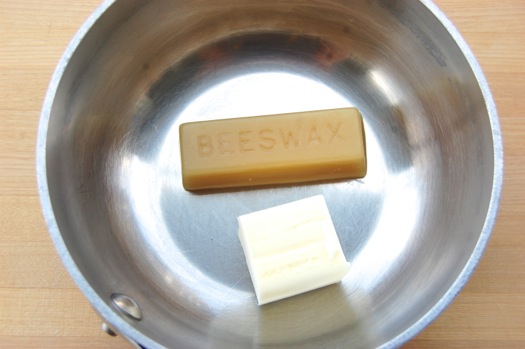
Melt it all together and let it cool to the point that you can comfortably touch it.
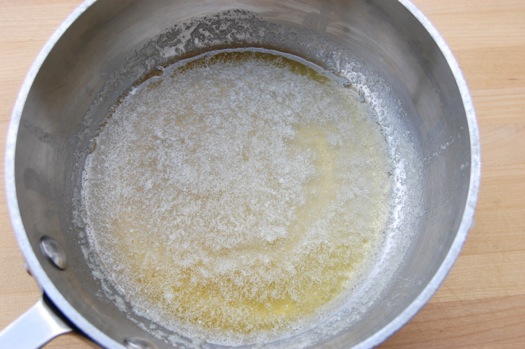
Why is it called “white oil”? I’m thinking it’s because it looks like this when it cools completely. Re-heat it in the microwave when you’re ready to use it. About 30 seconds on high should do it.
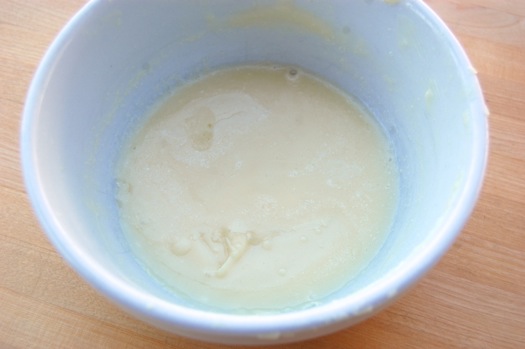
You can paint it on your molds or just use your finger. Guess which method I favor?

On baking day preheat your oven to 525 degrees Fahrenheit, or 500 if that’s all the higher your oven will go. Lubricate the molds if you haven’t already. When the oven is ready, remove the batter from the refrigerator. Skim off the foamy layer that’s on the top and discard it.

Now give the batter a gentle stir.
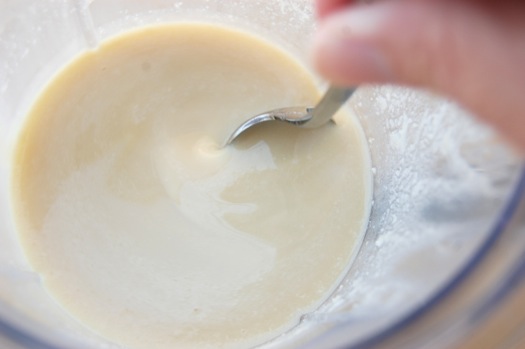
Fill the molds with the cold batter almost to the very top. I could have gone a touch higher here. No biggie.
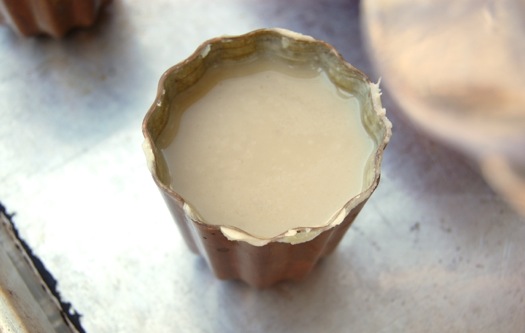
Bake them for 15 minutes at 525 then lower the oven to 400 for about another half hour until they look like this. They’ll dome a little in the oven but when they cool down a bit the tops may fall inward slightly. Knock them out while they’re still hot.
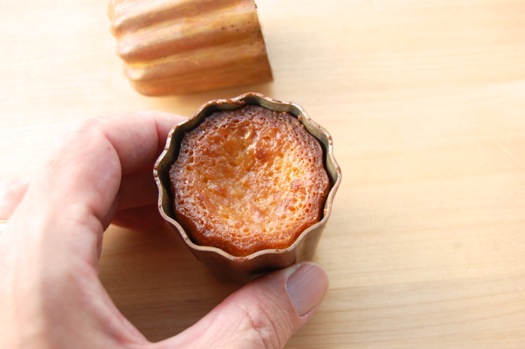
Here’s what you want the inside to look like. These are about perfect. Crunchy on the outside, soft, eggy and aromatic on the inside…very, very nice.
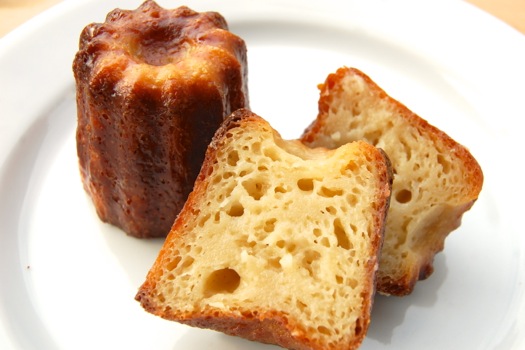
And now word about forms. I regret to say that while I struggled mightily for a formula that worked as well in silicone, I was unable to do it. Here’s how my best recipe performed.

Not awful, but not great either. The crusts didn’t form as well, plus as you can see from the above photo they rose out of their molds midway through baking. Why do they do that? Because of overly rapid heat penetration. The silicone lets too much heat in too fast, causing rapid expansion and eventual settling.

This is what they insides of the silicome baked ones looked like. Decent, not great. The double whammy of silicone is that later on in the bake they don’t transfer as much heat as metal, so you don’t get the crispy crusts. Or at least I didn’t. Dang!

All of which is to say that if you want to make good cannelés it seems you really do need to pay up for metal molds. So far I haven’t found a source for the less expensive aluminum molds that many French bakers use. Which leaves North Americans with no other option but copper…and those little buggers run $20 apiece. Ouch. This recipe makes ten.

Since this batter will keep well in the fridge, and because these custards only take 45 minutes instead of 2 hours, you could get away with buying five and baking them in batches. That reduces the expenditure to $100. Still…beeswax, copper molds…I admit these are not very “Joe”-like sweets. Still they’re excellent, not to mentioned gratifying to make since they have a reputation for being “impossible”. I feared them greatly myself. But having finally figured out what’s under the hood where cannelés are concerned, I’ll be making them often.
Did I mention they go great with red wine? They do!
I definitely understand the appeal of having harpooned your very own culinary white whale. And I love custard. But to someone who’s never eaten a cannelé and doesn’t own the mold, what’s the bottom line? Worth it?
Is it worth a $100 investment just to make cannelés? I’d have to say no. However if you can find some of the less expensive aluminum molds (other commenters are pointing toward some) you may well want to make the investment, since they’re a neat shape that you can bake other things in: crotins, small cakes, etc.. So overall I think it’s something worth considering. It depends on the extent that you like to experiment with different recipes and types of gear!
– Joe
I finally had an opportunity to try a cannalé. I was passing through the Minneapolis airport, and found it at Surdyk’s Flights, which sells fancy wines, fancy sandwiches, and fancy baked goods. (It’s in the airport’s mall, for anyone else here who might be passing through there.)
I thought it was good, but not worth making at home. I liked it’s eggy-ness, and also that it wasn’t too sweet. But with limited space in my kitchen for specialty forms, I think being in the audience while Mr. Pastry went through his struggles was sufficient for me. OTOH, for a serious cook who makes a great variety of things, then why not a cannalé, too?
I hear you, Brigitta! Especially when molds can run you big bucks. Thanks for the comment!
– Joe
Fantes offers the aluminum 2″ molds for $8.49 a piece
Nice! Thanks Arturo!
– Joe
OH! and this:
http://www.surlatable.com/product/PRO-348375/?affsrcid=Aff0001&mr:trackingCode=A762AEDC-D781-DE11-B7F3-0019B9C043EB&mr:referralID=NA&mr:adType=pla&mr:ad=30153266381&mr:keyword=&mr:match=&mr:filter=24156051701&origin=pla
Whew knew? Terrific! Thanks!
– Joe
Wow. Very impressive, very beautiful.
Does the batter change at all as it sits in the fridge for 2-3 days? Would canneles baked with 3-day old batter be significantly different than canneles baked with “fresher” batter?
Hey Chana! Thanks! The batter doesn’t change much after 24 hours. It may settle a bit more, but you stir it up before you use it anyway.
– Joe
Bravo Joe! So Proud of you for conquering the cannelés! One question. Does the rum only impart flavor or does it also help in some way to prevent the bubbles?
Eva
Hey Eva! Thanks very much! The rum is mostly for flavor. The alcohol all boils out during baking so there’s nothing left in the final product. I recommend it along with all the vanilla for plenty of flavor.
– Joe
glad you cracked the french code. the essence of the canele is that contrast between an exterior that is croustillant and an interior that is moelleux. baking at a really high heat, tempering with hot not warm milk, etc., it’s strange that most american recipes ignore those essentials. next time you might try in the tempering stage adding a small quantity of the hot milk to the eggs and sugar, then the flour, then the rest of the hot milk. that cooks the flour and seems to eliminate lumps and the need for straining.
Hey Candide! Thanks very much. It’s nice to have this finally figured out. And I did try adding the flour in two stages. It didn’t make a discernible difference to me, and still left some lumps, so I used the simpler approach (I poured the milk mixture into the eggs and sugar while it was still simmering, without a cooling period, so it still held plenty of heat). But there’s certainly nothing wrong with mixing that way if readers prefer it!
Thanks for all your help!
– Joe
I am going to Italy on vacation next week. I think I’ll look for some metal molds. At least, I can justify them as ‘souvenirs’.
Amen! And there are all sorts of things you can use them for if not these. I think they’re really cool!
Cheers and have fun!
– Joe
I was really happy to see you tackle cannelés on the blog. They’re a favourite of mine and I’ve never even attempted them before. Great walkthrough for this recipe as well. Thanks.
I think this recipe will work well for you. Let me know how they go when you try them!
– Joe
Ceux-ci sont magnifiques! I just might buy those cheaper metal molds and give these a whirl. You must be so relieved! Félicitations!
Yes, you might say that, Dave. It’s nice to finally understand what these things are. Now that they’re not such a mystery it’ll be easier to fiddle with them. Maybe I’ll make some chocolate ones next!
Thanks!
– Joe
HOORAY for you!!! Those look fantastic.
I got a silicone mold and tried to use it for crotins I was making as gifts. Thought the mold detailing would add a note of sophistication. Not so! Only the crotins on the exterior round of the one-piece mold were cooked enough to support their weight. The ones from the interior collapsed into sad little…uh…crottins. ::sigh:: (No one at my house complained about having to get rid of my abject failure.)
If I manage to follow your lead in being intrepid I’ll cut the mold into 2 parts that only have exterior compartments and only fill the cavities about 2/3 high.
Hey Rainey!
Thanks! You mean you tried making crotins in a cannelé mold and they wouldn’t stand up? I find that rather surprising. But these molds are both tall and wide. Heat has a hard time getting through.
Very interesting.
– Joe
Well, the ones in the periphery were stable but the ones that came from the interior cavities collapsed. They were baked well enough on the tops and bottoms but the middles just slunk.
I think the molds probably require convection heating for consistent baking. …or being cut into smaller units so each cavity has one exterior side with good exposure to the heat.
Interesting. Good to know!
I’m heading to the kitchen to mix up the batter to try these later in the week.
PLease let me know how they go, James!
– Joe
Holy cow – you did it! Woohoo! I have to say, as much as I love to get these at the patisserie down the block, I don’t think I’m going to take the plunge. Mind you, if ever I do, I know which recipe I’ll use!
Thanks K-line! And yes you can use this technique safely as long as you can source metal molds. I’ve found the formula and technique to be both reliable and repeatable!
– Joe
I can’t tell you how much I appreciate the labor you put into getting things right here. Sharing your failures with your successes and your thinking along the way does two things. First it helps us all think about baking, its an education in how things work. But more importantly it gives me confidence that if I need the thing to work I can trust your recipes to be proven.
It was a huge shock to me when I learned that not every recipe in a cookbook has actually been made by the author. I own slightly more than 200 cookbooks and some of them are natural disasters. Occasionally I can look at a recipe and tell it will not be right but I have ended with crap too often despite following a recipe that the author obviously did not. That is infuriating. So, while I imagine it can be frustrating at times for you, I just want you to know its not unnoticed.
Thanks very much for both the praise and confidence, Franky!
While I would much prefer to appear to be both infallible and a genius at all times, I can’t keep the blog going and not emerge from behind the curtain from time to time. There are far too many things in this world that I’ve never baked before. I ran out of projects that played to my strengths after about year three. So things had to change whereby the day-to-day baking became at least a little bit collaborative. These days I couldn’t do what I do if readers didn’t help me with recipes and tips!
But I also agree that it’s aggravating how many published recipes out there simply don’t work, and more than that, are never even tested before they go to print. And you never know who might fall down on the job this way. It seems a general rule that the bigger the celebrity the less reliable the recipes are, since the books tend to be cranked out fast and publishers know how few people actually cook from them. It’s a strange trade, cookbook publishing. There are reliable authors out there, it just can take some time to find them! Cheers,
– Joe
I got bitten with the canele bug some years ago after zoning in on them in London (I’m from Cape Town) – I have been utterly addicted ever since! The combination of custardy interior and caramelly outside is just sublime. Having made them a number of times, I thought I would chime in with a couple of my observations. Firstly, I find that resting the batter a full 3 days greatly reduces the risk of them rising too quickly and overflowing the molds. I can’t explain why, but it really has been borne out every time. Secondly, although most silicon molds perform poorly, the grey one by De Buyer (I can’t remember its exact name, but it’s grey rather than black) performs pretty much as well as copper. It forms a good, crunchy caramelly exterior that holds up after unforming.
Very interesting, Gretchen. I shall try those, since several people out there are lamenting the cost barrier of these things! 😉
Many thanks!
– Joe
Hi, Joe-
First, let me say how much I appreciate your wisdom AND your sense of humor. Second, let me admit my terror over making these little jewels. After watching a Unique Sweets episode highlighting Clear Flour Bakery and their canelés yesterday, I became a teeny bit obsessed with making them; ignorance was bliss, as I thought the only thing I had to fear in the baking world were Macarons (damn those tiny feet and fussy natures! I had every reason to fear them! Never again…) . After a bit of “research” — doesn’t that sound far more impressive than “Googling?”– I stumbled upon the attached post and am curious about your take on it. I was hoping against hope that a De Buyer mold, found at my local Surfas Restaurant Supply for $30-ish, would ensure some modicum of success. (Self-delusion, thy name is hopeful home baker…). Beeswax I can take. Tiny little uni-tasking $20+ molds not so much… Any thoughts on this post before I rush out to purchase anything?
http://chezpim.com/bake/caneles-silicone-molds
Many thanks, in advance, for sharing even more of your wisdom with me!
Hey Carissa!
For some reason I can’t access the post, I keep getting a server error message. What I can tell you is that I didn’t have a lot of luck with silicone. But perhaps I was using the wrong molds. A reader commented that the grey molds were made of a different material than the red ones, and performed much more like the traditional copper. For me copper, combined with the technique that I slaved over (really, one of the hardest weeks of my blogging career getting the formula down) did the trick. But who can afford $300 for a dozen stupid cannelé molds? Let me know how your experiments turn out — and get in touch if you run into trouble…those little things can be demons!
– Joe
Aren’t you fabulous to reply so promptly! Interestingly, the link I forwarded (sorry for the frustration of not being able to open it) shows a grey De Buyer mold, not a red one. The author of the forwarded blog geeked out a bit over beeswax vs. butter vs. “naked,” which I found interesting. I so appreciate other (more patient) people such as yourself going through trials and tribulations to figure out the best approach to baking something that seems…unapproachable. A Google search for “Chez Pim Make (Almost) Perfect Canele Silicone Mold” will lead you to her research, which, I think, compliments yours. Who knows, this wonderful post of yours was long enough ago that you’ve moved on to something equally compelling and terrifying…like Kouign Amann? (Shuddering just mentioning it…)
Again, many thanks, Joe. You’re a gem.
KOUIGN AMANN???
Slowly I turned…
Those words give me PTSD only because, like cannelés, it took me over a dozen tries before I finally got it right. At the time I did the post there were no commonly available recipes that did not include the fatal mistake of combining the sugar with the butter (someone obviously just made it up without testing it). In all modesty I can tell you that the final recipe and instructions I came up with are not only a.) not difficult but b.) foolproof. It was an achievement, but it cost me dearly in elevated blood pressure.
Don’t worry about the beeswax minutia for goodness sake. I remember that post from when I was wrestling with the cannelés…it didn’t help! 😉
Keep in touch!
– Joe
Hey! Just came back from Paris with a visit to MORA to get the aluminum molds for a few euro each. Having a successful bake this morning — need to spray the molds first before the beeswax because I always miss a spot.
Other than that — they’re pretty ideal! Crusting/caramelization is great. I don’t know how it works out with the shipping charges but MORA will ship and they have nonstick metal as well.
http://www.mora.fr/fr/produits_liste.asp?ID_SousFamille=130&MenuActif=0&SsMenuActif=23
Very nice, Florine! Thanks for the information!
Cheers,
– Joe
I have a mad question… do you think canneles could be made in a waffle iron? I was making waffles this morning (and was shocked that you don’t have a recipe on the site!) and thought of how similar the batter and finish are, crispy brown on the outside and moist on the inside. Am I insane? Could it work? Please advise before I waste a lot of eggs!
Hang on a second. What’s this?
http://joepastry.com/category/pastry/waffles/
The thing cannelé batter most closely resembles is crèpe batter, which is of course a type of pancake. Not being as rich as waffle batter, it won’t crisp like a waffle. But I see no reason why it wouldn’t cook. Send pictures if you try it!
Cheers,
– Joe
wow! I’m really bad at using the internet it seems! Thanks for the waffle recipe. I’ll totally send pics if I get up the nerve to try make some Canaffles.
You may start a wild new cronut-like trend, Martina. Remember that I want a cut of the action.
– Joe
Bien sûr.